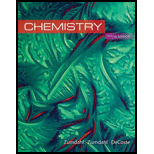
(a)
Interpretation: A proposed mechanism of a destruction of ozone in upper atmosphere and the first step mechanism for the chlorine catalyzed ozone destruction are given. The answers are to be stated for the given options.
Concept introduction: The substance that speeds up the
The intermediates are the transient species that is capable to produce the desired product directly.
To determine: The overall balanced equation for the destruction of ozone.
(b)
Interpretation: A proposed mechanism of a destruction of ozone in upper atmosphere and the first step mechanism for the chlorine catalyzed ozone destruction are given. The answers are to be stated for the given options.
Concept introduction: The substance that speeds up the rate of reaction without getting consumed itself in a chemical reaction is known as catalyst.
The intermediates are the transient species that is capable to produce the desired product directly.
To determine: The catalyst in the mechanism for the destruction of ozone in upper atmosphere.
(c)
Interpretation: A proposed mechanism of a destruction of ozone in upper atmosphere and the first step mechanism for the chlorine catalyzed ozone destruction are given. The answers are to be stated for the given options.
Concept introduction: The substance that speeds up the rate of reaction without getting consumed itself in a chemical reaction is known as catalyst.
The intermediates are the transient species that is capable to produce the desired product directly.
To determine: The intermediate in the mechanism of a destruction of ozone in upper atmosphere.
(d)
Interpretation: A proposed mechanism of a destruction of ozone in upper atmosphere and the first step mechanism for the chlorine catalyzed ozone destruction are given. The answers are to be stated for the given options.
Concept introduction: The substance that speeds up the rate of reaction without getting consumed itself in a chemical reaction is known as catalyst.
The intermediates are the transient species that is capable to produce the desired product directly.
To determine: The rate law, if first step is slow and second step is fast.
(e)
Interpretation: A proposed mechanism of a destruction of ozone in upper atmosphere and the first step mechanism for the chlorine catalyzed ozone destruction are given. The answers are to be stated for the given options.
Concept introduction: The substance that speeds up the rate of reaction without getting consumed itself in a chemical reaction is known as catalyst.
The intermediates are the transient species that is capable to produce the desired product directly.
To determine: The second step in the mechanism for chlorine catalyzed ozone destruction and the overall balanced equation.
Trending nowThis is a popular solution!

Chapter 20 Solutions
Chemistry
- Identify the compound with the longest carbon - nitrogen bond. O CH3CH2CH=NH O CH3CH2NH2 CH3CH2C=N CH3CH=NCH 3 The length of all the carbon-nitrogen bonds are the samearrow_forwardIdentify any polar covalent bonds in epichlorohydrin with S+ and 8- symbols in the appropriate locations. Choose the correct answer below. Η H's+ 6Η Η Η Η Η Ηδ Η Ο Ο HH +Η Η +Η Η Η -8+ CIarrow_forwardH H:O::::H H H HH H::O:D:D:H HH HH H:O:D:D:H .. HH H:O:D:D:H H H Select the correct Lewis dot structure for the following compound: CH3CH2OHarrow_forward
- Rank the following compounds in order of decreasing boiling point. ннннн -С-С-Н . н-с- ННННН H ΗΤΗ НННН TTTĪ н-с-с-с-с-о-н НННН НН C' Н н-с-с-с-с-н НН || Ш НННН H-C-C-C-C-N-H ННННН IVarrow_forwardRank the following compounds in order of decreasing dipole moment. |>||>||| ||>|||>| |>|||>|| |||>||>| O ||>>||| H F H F H c=c || H c=c F F IIIarrow_forwardchoose the description that best describes the geometry for the following charged species ch3-arrow_forward
- Why isn't the ketone in this compound converted to an acetal or hemiacetal by the alcohol and acid?arrow_forwardWhat is the approximate bond angle around the nitrogen atom? HNH H Harrow_forwardOH 1. NaOCH2CH3 Q 2. CH3CH2Br (1 equiv) H3O+ Select to Draw 1. NaOCH2 CH3 2. CH3Br (1 equiv) heat Select to Edit Select to Drawarrow_forward
- Complete and balance the following half-reaction in acidic solution. Be sure to include the proper phases for all species within the reaction. S₂O₃²⁻(aq) → S₄O₆²⁻(aq)arrow_forwardQ Select to Edit NH3 (CH3)2CHCI (1 equiv) AICI 3 Select to Draw cat. H2SO4 SO3 (1 equiv) HO SOCl2 pyridine Select to Edit >arrow_forwardComplete and balance the following half-reaction in basic solution. Be sure to include the proper phases for all species within the reaction. Zn(s) → Zn(OH)₄²⁻(aq)arrow_forward
 Chemistry & Chemical ReactivityChemistryISBN:9781337399074Author:John C. Kotz, Paul M. Treichel, John Townsend, David TreichelPublisher:Cengage Learning
Chemistry & Chemical ReactivityChemistryISBN:9781337399074Author:John C. Kotz, Paul M. Treichel, John Townsend, David TreichelPublisher:Cengage Learning Chemistry & Chemical ReactivityChemistryISBN:9781133949640Author:John C. Kotz, Paul M. Treichel, John Townsend, David TreichelPublisher:Cengage Learning
Chemistry & Chemical ReactivityChemistryISBN:9781133949640Author:John C. Kotz, Paul M. Treichel, John Townsend, David TreichelPublisher:Cengage Learning Chemistry for Engineering StudentsChemistryISBN:9781337398909Author:Lawrence S. Brown, Tom HolmePublisher:Cengage Learning
Chemistry for Engineering StudentsChemistryISBN:9781337398909Author:Lawrence S. Brown, Tom HolmePublisher:Cengage Learning ChemistryChemistryISBN:9781305957404Author:Steven S. Zumdahl, Susan A. Zumdahl, Donald J. DeCostePublisher:Cengage Learning
ChemistryChemistryISBN:9781305957404Author:Steven S. Zumdahl, Susan A. Zumdahl, Donald J. DeCostePublisher:Cengage Learning
 Chemistry: Principles and PracticeChemistryISBN:9780534420123Author:Daniel L. Reger, Scott R. Goode, David W. Ball, Edward MercerPublisher:Cengage Learning
Chemistry: Principles and PracticeChemistryISBN:9780534420123Author:Daniel L. Reger, Scott R. Goode, David W. Ball, Edward MercerPublisher:Cengage Learning





